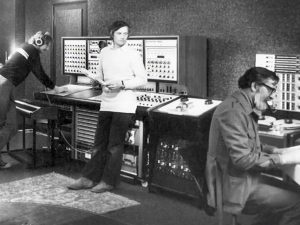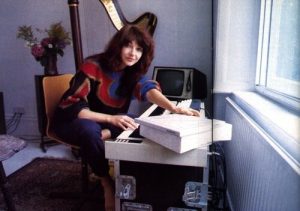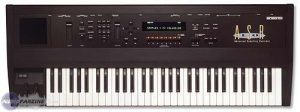Background
The demand for electronic musical instruments had been growing steadily throughout the 1960s as musicians and composers became more interested in the possibilities of manipulating sound electronically. From monophonic “additive” synthesizers using sine wave generators to experimental instruments with complex oscillators that could produce many different harmonic components, the field was rapidly evolving.

A new concept for EMS
 EMS had been making all-electronic music studios since 1960, and their catalogue included an extensive line of modules for voltage-controlled synthesis, including complex systems such as the Synthi 100. The Musys was a departure from their traditional design practice as it was the first digital sampler.
EMS had been making all-electronic music studios since 1960, and their catalogue included an extensive line of modules for voltage-controlled synthesis, including complex systems such as the Synthi 100. The Musys was a departure from their traditional design practice as it was the first digital sampler.
Groundbreaking design
Conceived and designed by Peter Grogono in 1969 for EMS. It was designed specifically to playback prerecorded samples of sounds. Instead of making a system that included every possible function in one box, Grogono decided to break up the processing into separate modules that could then be connected together in various ways.
 The system ran on two mini-computers, a pair of Digital Equipment’s PDP-8sOffsite Link. This had a tiny memory of 12k (12000 bytes) with an additional 32 k backing up from tape storage all this was absolutely minuscule by today’s standards yet still, these little computers were used as world-first music samplers and controllers in what became known as “The first digital Studio”.
The system ran on two mini-computers, a pair of Digital Equipment’s PDP-8sOffsite Link. This had a tiny memory of 12k (12000 bytes) with an additional 32 k backing up from tape storage all this was absolutely minuscule by today’s standards yet still, these little computers were used as world-first music samplers and controllers in what became known as “The first digital Studio”.
The Musys featured the first digital sampling keyboard. When a key was pressed on the keyboard, no sound would play from its output until an analogue-to-digital converter read in a corresponding value from a memory unit storing a prerecorded sample.
Life cycle and evolution
 Although The Musys did not see widespread adoption, it was the first step toward more revolutionary developments in digital synthesis. The Fairlight and the Synclavier were early trailblazers encouraging musicians like Peter Gabriel and Kate Bush to use this new music-making tools
Although The Musys did not see widespread adoption, it was the first step toward more revolutionary developments in digital synthesis. The Fairlight and the Synclavier were early trailblazers encouraging musicians like Peter Gabriel and Kate Bush to use this new music-making tools
These were followed by improved models throughout the 80s. Making sampling more widespread and available to all. These included the Emulator 1 (1980), which featured an isolated keyboard that does not require a master unit like the Musys, and the Emulator II (1984) which was the first sampler to use 3.5″ floppy disks as storage media instead of large, expensive magnetic tapes such as those used in the Musys. Other notable samplers were the Akai S900 and the ASR 10 from Ensoniq which was my first sampler. 
Today, computer-based digital sampling has completely revolutionized music production and changed the course of many musical styles. Although most modern-day producers use software programs rather than dedicated hardware units.

